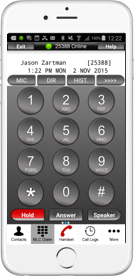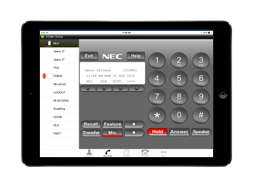![]()
In our third and last post discussing Unified Communications we will focus on Mobility technology and its role in bringing the mobile work force closer by providing quicker and more efficient interaction with customers and co-workers. Mobility refers to any application developed for a mobile device that facilitates business outside of a typical office environment. The improved screen size and power of mobile devices coupled with the ongoing movement of employees outside the office has created a need for better communications using their mobile devices.
Mobility applications have allowed the new outwardly mobile employee to take their desk phone along with them in app form. Calls to the company phone system can be transferred with the same ease as transferring a call from one office extension to another, so the caller does not have to hang up and call a different number, keeping the call within the company voice network. If the call goes unanswered, the message is left in the phone system voicemail and not on the cell phone. This allows companies to keep their customers and employees all within easier reach. Another benefit for many is that, calls placed from the mobility app show the company main number and not the cell phone number. If an employee leaves the company, the application can be quickly and easily disconnected from the employee cell phone lessening the possibility of customer poaching.
keeping the call within the company voice network. If the call goes unanswered, the message is left in the phone system voicemail and not on the cell phone. This allows companies to keep their customers and employees all within easier reach. Another benefit for many is that, calls placed from the mobility app show the company main number and not the cell phone number. If an employee leaves the company, the application can be quickly and easily disconnected from the employee cell phone lessening the possibility of customer poaching.
The mobility app connects to the phone system over Wi-Fi or cellular LTE and can be secured with a VPN client. It can be configured to hand off connection seamlessly from LAN Wi-Fi to LTE as the device leaves the local area network and vice-versa upon return to the building. Using Wi-Fi instead of PTE when possible, helps avoid the common problem of poor in-building cellular signal.
 Mobility is not limited to cell phones. Tablets have also become a common tool for conducting business while outside the office. The tablet's integration to common business applications such as spreadsheets, word processing and email, combined with the mobility communication application has transformed the tablet into one innovative, feature-packed business device.
Mobility is not limited to cell phones. Tablets have also become a common tool for conducting business while outside the office. The tablet's integration to common business applications such as spreadsheets, word processing and email, combined with the mobility communication application has transformed the tablet into one innovative, feature-packed business device.
Mobility Benefits:
- Anywhere, anytime access to desktop telephone functionality
- Provides single number reach, simultaneous ringing of devices and access to voicemail
- Easy transfer of calls to and from mobile device and desktop telephone
- Operates internally on corporate Wi-Fi or outside the network via cellular LTE
- Syncs and provides access to device and MS Outlook contacts
- Provides access to Call Logs (Missed calls, Outgoing and Incoming calls)
- Two-way video calls between mobility app users
In the End
There are many business challenges that are answered with a robust mobility solution. It extends the reach of your staff and allows for increased efficiency and flexibility and allows responses to be immediate, regardless of the user’s location—meeting the challenge of availability, so important to customers and colleagues alike. Mobility is highly adaptable and can be customized for each individual’s needs which results in better efficiency and higher productivity. It gives users the visual displays and features needed to perform their job intelligently, connected to the network.



 Unetek
Unetek 